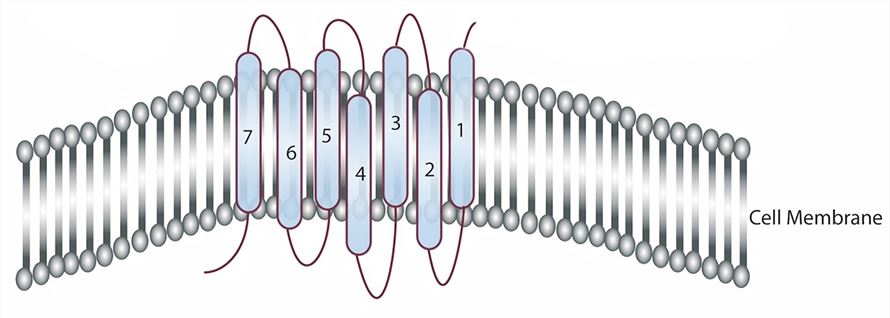Introduction of BRS3
BRS3 is a 399-amino-acid orphan G protein-coupled receptor (GPCR) of the bombesin receptor family. Besides BRS3, this family of mammalian bombesin receptors consists of other two receptors: the gastrin-releasing peptide receptor (GRP-R) and acid neuromedin B receptor (NMB-R). This family of cognate GPCRs mediates biological effects through high-affinity binding of bombesin-like peptides (BLPs) mainly by paracrine and neurocrine mechanisms of actions. The orphan BRS3 has been reported to be expressed in the central nervous system (CNS), peripheral tissues, human lung and breast carcinoma cell lines as well as other epithelial tumors, carcinoid tumors, etc.
| Basic Information of BRS3 | |
| Protein Name | Bombesin receptor subtype-3 |
| Gene Name | BRS3 |
| Aliases | BRS-3 |
| Organism | Homo sapiens (Human) |
| UniProt ID | P32247 |
| Transmembrane Times | 7 |
| Length (aa) | 399 |
| Sequence |
MAQRQPHSPNQTLISITNDTESSSSVVSNDNTNKGWSGDNSPGIEALCAIYITYAVIISVGI LGNAILIKVFFKTKSMQTVPNIFITSLAFGDLLLLLTCVPVDATHYLAEGWLFGRIGCKVLS FIRLTSVGVSVFTLTILSADRYKAVVKPLERQPSNAILKTCVKAGCVWIVSMIFALPEAIFS NVYTFRDPNKNMTFESCTSYPVSKKLLQEIHSLLCFLVFYIIPLSIISVYYSLIARTLYKST LNIPTEEQSHARKQIESRKRIARTVLVLVALFALCWLPNHLLYLYHSFTSQTYVDPSAMHFI FTIFSRVLAFSNSCVNPFALYWLSKSFQKHFKAQLFCCKAERPEPPVADT SLTT LAVMGTVPGTGSIQMSEISVTSFTGCSVKQAEDRF |
Functions of BRS3 Membrane Protein
BRS3 is present widely in the central nervous system and peripheral tissues and primarily receptor-knockout studies suggest it is involved in metabolic-glucose-insulin homeostasis, feeding and other CNS behaviors, gastrointestinal motility and cancer growth. Firstly, its expression is reduced in skeletal muscle from obese and diabetic patients. BRS3-deficient mice develop mild obesity and unbalanced glucose metabolism. As a result, BRS3 and its agonist are potential therapeutic tools for obesity/diabetes. Moreover, BRS3 is widely expressed on certain cancer cells and a number of studies have reported their involvement in invasion and metastasis of these cancer cells. Recently, studies have shown that investigators might have overlooked the role of BRS3 in the treatment and/or diagnosis of lung cancer.

Applications of BRS3 Membrane Protein in Literature
This study investigated the frequency/relative quantitative expression of human BRS3 and the effects of its activation on cell-signaling/growth in 13 different human lung-cancer cell-lines. The results showed that BRS3 might be a potential approach for the development of novel treatments and/or diagnosis in lung cancer.
This article reported the synthesis and evaluation of novel agonists of bombesin receptor subtype-3, laying a foundation for the development of anti-diabetes and obesity drugs.
This article investigated BRS3 expression in skeletal muscle from normal, obese or type-2 diabetic patients and the effect of BRS3-agonist-peptide on glucose-related effects, before or after BRS3 gene silencing. The results showed that BRS3 played an important role in glucose metabolism and could be used as a molecular target for obesity and diabetes treatment.
This study characterized the affinities, potencies, selectivities of the chiral-diazepine BRS3 agonists in human and rodents.
This study investigated the molecular basis for high affinity/selectivity of the Bantag-1, a peptide-antagonist of BRS3 receptor using a chimeric-approach making both Bantag-1 loss-/gain-of-affinity-chimeras.
BRS3 Preparation Options
To obtain BRS3 in solubilized and stable formats that maintain their structural integrity and function, Creative Biolabs offers a wide range of preparation options using different strategies and approaches. Your project will be analyzed professionally on a case-by-case basis in order to find a better match for your particular target. See Magic™ Membrane Protein Production Service. Aided by our versatile Magic™ anti-membrane protein antibody discovery platform, we also provide customized anti-BRS3 antibody development services.
Creative Biolabs has years of experience reconstituting challenging membrane proteins and optimizing the incorporation process. We can also tailor our service packages to suit your specific requirements. contact us to request more information and discuss your project goals with our seasoned scientists.
All listed services and products are For Research Use Only. Do Not use in any diagnostic or therapeutic applications.